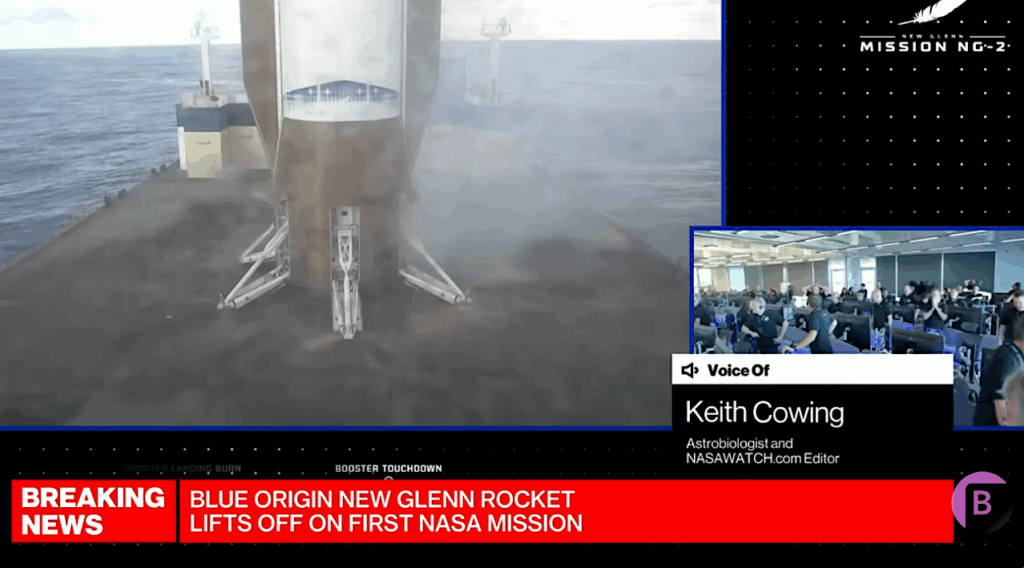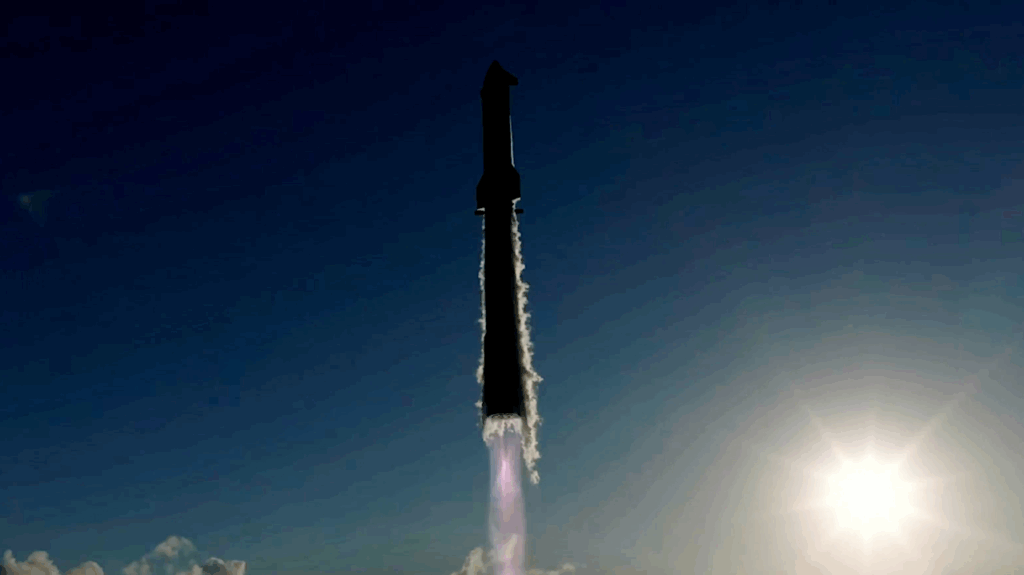SpaceX Grasshopper Software First
 Grasshopper 325m Test | Single Camera (Hexacopter) [Watch],SpaceX
Grasshopper 325m Test | Single Camera (Hexacopter) [Watch],SpaceX
“On June 14, SpaceX’s Grasshopper flew 325 m (1066 feet)–higher than Manhattan’s Chrysler Building–before smoothly landing back on the pad. For the first time in this test, Grasshopper made use of its full navigation sensor suite with the F9-R closed loop control flight algorithms to accomplish a precision landing.”









A nice smooth test from what I saw. That autonomous landing control system will doubtless appear in some form on the propulsive-landing version of Dragon.
Have not looked at the video yet, but about too.
That sure looked smooth to me. So cool, I have been waiting for them to release this!
I wonder how soon we will see a cargo dragon do a soft landing. without swimming like a duck??
DTARS:
Any gains they make with Grasshopper can go right into Dragons flight computer. Closed loop systems (which I’ve written myself) are very flexible that way. Robots like this react to the environment around them and change what systems they have to meet conditions set for them. The same high level algorithm can ‘talk’ to low level engine controls without ‘knowing’ whether it’s a Merlin or Draco, only knowing the throttle range and limits of control. Sensor data would be the same for both Falcon and Dragon so how it was processed would be the same too.
We could soon see a crewed Dragon go through the same flight test sequence as Grasshopper, making successively higher flights to master terminal approach and landing. This could be happening in parallel with the two upcoming launch abort tests.
tinker
These tests remind me the work Robert Goddard use to do in his later years. I’ll bet he would grin like crazy watching this, and then ask what took you so long to do this kind of work??
I think Goddard’s work can be considered private development (though not commercial as he was not planning to provide launch services) though he had funding from Smithsonian (I cannot remember specifics right now). Goddard had to do it himself as we seen much of his work was ignored until after WWII. I think Goddard’s reaction to what SpaceX is doing, “If I had these tools and capabilities, I’d be going to Mars right now.”
I still find these flights amazing. 2 years ago, if I would have seen this in a movie, I would have considered it an unrealistic special effect.
10-story automated VTVL rocket flight recorded by a robotic hexacopter. Welcome to the future.
I showed this to a young man that is a 35 year old iron worker. Lol his response was “it looks fake dude”
we have a lot of work to do to convince the world that future in space is once again possible. So much rides on Elon Musk, the man that dared to say “I can do that cheaper and better”.
A lot of cool stuff was known to be absolutely impossible until the first time people actually saw it happen (like heavier-than-air flight and rockets working in space). And sometimes people refuse to accept things even when they do see them happen. The Photoshop Effect seems to have invaded video and reality as well as pictures.
I prefer to believe in Clarke’s First Law: When a distinguished but elderly scientist states that something is possible, he is almost certainly right. When he states that something is impossible, he is very probably wrong.
Let’s just leave it at Arthur C. Clarke being a great author. His judgements about science….well, they have their fans, I guess. I’d be more inclined to listen to another scientist than I would do invest in things like Clarke’s First Law.
I believe Clarke himself was able to take his statement in context… Then it becomes a rallying cry for “don’t believe the scientists” and that’s just silly.
It’s a very popular rallying cry, especially given the distrust of science by the general public. Rather than endeavor to understand things, it’s easier to deny things.
I stand by the validity of the concept in his “law.” I don’t weigh it based on who said it. At the same time, while Clarke himself refused to be considered a profit or an oracle, he was right about the future, or close to it, more often than many, perhaps even most, fiction writers and scientists. Proposing comm sats was, all by itself, was enough of a prediction to put him in the history of science books, in my opinion.
Well, not everyone has to follow science I guess
Don’t mistake optimism for anti-science. I’ve been studying various sciences for decades (and enjoying it). Don’t dismiss Clarke because he wrote SF; he also wrote pure science books, and many top notch science people are also SF writers (Geoff Landis, a NASA Watch regular, among them).
Yep, geostationary orbit.
I hope we start seeing actual launches filmed this way. Let’s you get closer without risking any people, or the rocket.
Agreed Paul. My only comment is that the hexacopter view from above seemed to compress the vertical, making the Height above Ground and vertical velocity vector seem too low and too slow, respectively. It improved once the LV approached the hexacopter height, but then compressed again when the LV went back down. At least, that’s how it looked to me. Moving the hexacopter horizontally a little further from the pad may have reduced this effect at the cost of a little close-up detail. Then again, maybe I just need new glasses.
Maybe hexacopters every 300 ft 🙂 If one hexacopter takes a dump, no problem, you just miss out on one shot.
I love that the audio is from the hexacopter too.
C1:
Grasshopper is beginning to look like it’s own movies! 🙂
tinker
Landing at a specific place using a navigation system seems to be a tremendous advance. With GPS systems iot should be possible to also land from miles up and downrange.
That’s something I’m wondering about. The report said it was their first use of a “full navigation sensor suite with the F9-R closed loop control flight algorithms” and “an additional, higher accuracy sensor was in the control loop“, but it doesn’t specifically say that the additional sensor is attached to the LV. What if the precision control they’re talking about is accomplished by an added sensor at the landing site? (actually it would have to be offset from the landing site to survive). That would make for a much less capable situation.
I’m not saying that this is the case, just that it hasn’t been described as not being the case.
I think it’s more likely to be a higher accuracy location sensor/GPS set in the control loop than a sensor in the pad.
GPS by itself isn’t optimal due to unpredicted variations in propagation times for radio waves passing through the atmosphere. In aviation there are two ways of increasing accuracy, either Wide Area Augmentation which uses ground GPS receivers at precisely known locations across the country that calculate regional GPS position error and provide correction factors, and Local Area Augmentation by correction factors from GPS receivers at the actual destination airport, which is even more accurate (less than 1 meter). However direct ranging between the rocket and ground-based sensors or transponders near the pad would still be the most precise method when close to the ground.
At this point in the game, I suspect a ground sensor has been added, but I’d like to see them working towards a complete on-board system with GPS augmentation, which would give them enough accuracy to land anywhere in case of emergencies, storms, fuel loss. whatever. Basically, if it had all of the alternatives that a commercial airliner has then no one could really argue against their use anywhere.
But, I guess that’s something optimistic for the future. First the Grasshopper has to take the pebble from my hand.
Since they won’t be having to line up with and land on a runway, and just need to land in any open area at the airport, I would think that INS would be good enough accuracy as a backup to GPS. Or use the local airport’s VORTAC system.
There would be a risk of possibly starting a grass fire if they don’t wind up coming down on concrete, but since fire crews will already be there that shouldn’t be an issue.
Good point. I think range and bearing to VORTAC, or any known nearby beacon, would be a good way to check/calibrate GPS. They could maybe even adapt to ILS (a rocket glide slope, now that’s one I’ve never thought of before).
INS wouldn’t do it, I don’t think. Accumulated errors are typically large compared to GPS resolution. Aircraft query waypoint beacons along their flight path and look up their lat/long in an on-board data base to continually update their inertial position (via range and bearing to the known waypoint). Since the F9, or other LV, is presumably coming in with a high vertical rate relative to its horizontal speed it may not be passing over many, or even any, waypoints at a low enough velocity/altitude during landing approach to get local corrections.
I think it’s safe to say that any LV landing / positioning system that makes use of existing airport facilities is going to be the most popular, and certainly the cheapest to implement. In fact, if the regulatory people are proactive for once, they’ll make that a requirement. There is precedent, like ASCII, RS232 and color TV; but then again they did roll over and go back to sleep on lots of other issues, like stereo AM radio.
(Re: Color TV — NTSC was not the first color TV system demonstrated in the US. It was done years earlier by the CBS Network labs. But the FCC wisely stepped in and said the color TV signal format must be displayable on existing B&W TVs, and B&W TV signals must be displayable on color TVs, all without adding or changing any TV equipment. AM stereo was the opposite. Five companies had working prototypes of their different systems and asked the FCC to pick one as the standard so they could get on with manufacturing. The FCC just said let the marketplace sort it out, so nobody took it any further. Both sides had “cause” because this was right after the time when the Beta video tape system, clearly the superior system, was slain and buried by VHS. The Japanese [JVC] knew how to play hardball and the US, among others, let them get away with it. Right! That’s enough from the WayBack machine.)
And don’t forget the RCA CED videodisc vs Pioneer’s LaserDisc (no real contest there) and the later battle between HD DVD and Blu-ray. Hopefully when it comes to docking standards the Beta vs. VHS lesson has been learned so that we don’t wind up with the equivalent of a VHS docking standard just because of someone’s clever marketing.
The grasshopper tests, done entirely by private industry, are well in advance of anything NASA-managed programs have done in both conception and execution. To deny that commercial spaceflight is now America’s lead program for human and cargo launch flies in the face of reality.
DC-X?
DC-X was an impressive achievement, but cancelled, like all the NASA reusable launch programs of the 90’s. Some of its ideas and people have transitioned to privately-funded Blue Origin and may yet make a major contribution in reusability, but (SFAIK) are not currently planning or capable of orbital flight.
Additionally, DC-X was an entirely bespoke system, intended solely for the test program. Likewise all those lovely Masten landers.
Grasshopper not only came off the F9 production line, its systems are already feeding back into the next version of F9 launcher.
So Grasshopper was based on an F9 v1.0. It tested systems that were integrated into the production F9 v1.1 and those systems will be tested during actual launches. Then the next Grasshopper will be based on an that F9 v1.1 and will test further systems that will then feed into the F9 v1.2 or possibly the final F9R.
That feedback loop is entirely new. No one has ever done that with a VTOL system before.
Paul:
Interesting that closed loop systems haven’t been used this way because they are perfectly suited to high power, time compressed, multiparameter situations like this.
The first launch failure of the Ariane 5 could have been avoided with closed loop flight software. The Ariane 4 parameter that caused the failure would have simply been ignored and the flight would have continued using other redundant variables.
tinker
v4,
Although I agree with the sentiment of your statement, when you consider all of the performance aspects — as compared to the current customer requirements — the case can still reasonably be argued in either direction. Once they add people into the equation and put them into space and bring them back whole, then your statement becomes beyond dispute. Right now, Soyuz can do things that SpaceX hasn’t yet accomplished the milestones for. They’ll have to proceed by the numbers to get the HSF contracts, which is what I think they really want. When (not if) that happens, a whole lot of things are going to change and those in Congress who have been holding back “commercial space” will find themselves standing alone.
Points well taken from you and psisquared. But in my own defense I said it was “America’s” leading program. That would not include Soyuz, or Shenzou, which is in some respects significantly ahead of Soyuz, or, on the cargo side, Ariane. I should have avoided the impression of chest-thumping. My point was that there are still those who denigrate Commercial Space as saving money only by cutting corners and not being the “real” space program. But in remaining focused on doing useful tasks at affordable cost by applying new ideas, SpaceX has proven itself the best answer to the needs of NASA, with its limited funding, and of America in the 21st century.
OK, I misunderstood. I see Soyuz as a “private industry” “commercial” provider and America is using them, so I assumed they were included.
You also have to admit that NASA has done some things that are well in advance of any SpaceX programs. Frankly, I find the back and forth chest thumping about who is better a bit tiresome and a big waste of energy. Such back forth certainly achieves absolutely nothing, so in that resect it’s very much like Congressional battles over space.
I think the need by some to constantly assert this is because they miss the point about what SpaceX has actually done.
The point of Falcon9 is not “oh another 10T-to-LEO rocket, big deal, the ’50s called and they want their Redstone program back”, it’s that SpaceX developed an entire launcher (actually two) and engine program in-house, on minimal funding, with no guarantee of government support. This is radically different from EELV or SLS… or Ariane or Soyuz or…
The point of Dragon-Rider is not “oh a manned LEO capsule, the ’60s called and they want their Gemini program back”, it’s that this will be a fully commercial American manned capsule. That is, regardless of government contracts, any private customer can buy a seat (or indeed an entire flight). The only rival for that is the Russians, and only on a cramped 3-seat Soyuz capsule, paying almost as much per-seat as you’d pay for an entire 7-seat Dragon-Rider capsule. In the four+ decades since Gemini, none of the Mercury/Gemini/Apollo contractors has even attempted to develop a simple manned commercial capsule. Not when the shuttle development was delayed in the ’70s. Not when it was grounded in the ’80s. Not when NASA was casting around for a “lifeboat” for the ISS in the ’90s. Not when the shuttle was grounded and likely to be cancelled in the early 2000s. Even today, of the Primes, only Boeing is developing a commercial capsule, and only in response to a specific NASA program, and only investing as little as possible of its own money into the project.
The point of Grasshopper is not “oh an experimental VTOL rocket, the ’90s called and they want their DC-X program back”, it is (as I’ve commented to Vulture elsewhere) that this particularly VTOL is directly feeding back into an existing launcher program. No other VTOL test vehicle has ever done that. For example, while Masten’s XEUS tester will be built around a recylced Centaur upper-stage, it is not a test program for the Centaurs, not one shred of Masten’s Xeus technology will be channelled back into the Centaur program.
SpaceX recently cut a deal to lease some space/time at the New Mexico spaceport , same place where Virgin Galactic will start doing suborbital tourist flights. SpaceX need more ” room” for Grasshopper to make some very high altitude VTVL test flights, and begin working on that High Alpha trajectory flight . Getting a booster flying a couple thousand miles an hour to come about 180° and fly home and land on its feet… now THAT will be some Big Whoop video !
I wonder if the cowboy mannequin ” Tex” made this last hop , standing on the railing above the engine.
I’m wondering how they’re going to capture video of that flight. They’ll have to use multiple overlapping-position chase planes to catch it all. The breaks in the video when it switches from one plane to the next will almost certainly bring out the nay-sayer nuts yelling “faked!”.
Even with supersonic chase planes, they’ll only catch it all if the LV flight goes exactly as planned. Anybody out there got a supersonic hexacopter?
What is the flame on the legs????
Could it super dracos getting a little flight experience??
Lolol just a crazy long shot! Lolol
It’s a heat-resistant covering on the test legs burning off.
DTARS:
Nope, that’s just blow back from the Merlin. If you look at the landing leg SpaceX showed off you’ll see that the composite ‘strut’ is wider than it needs to be. This will help deflect the blow back down once all four are open.
tinker
Your closed loop comment helped tinker thanks 🙂
DTARS:
BTW: Drew this up using MSPaint on a whim. Self explanatory. 😉
Even if this was just a diagram for the cargo arrangement it would still need a heat shield to deliver any reasonable payload to the martian surface. In my opinion MCT is almost certainly a large rocket whit a large capsule! and I think it will use the large capsule for the aerobraking of the second stage. It’s a quite simple design and has many advantage’s and I would be shock if this isn’t what Elon is thinking because it’s basically an f9r and Dragonrider scaled up whit methane engine’s. I’d put my house on it, if i had one that is. 😀 note: the capsule is switched around when in orbit,
TB123:
The idea here is a ‘ferry’ from Earth to Mars, no stops along the way. You don’t barge cars one by one to a ferry sitting in the harbour, it’s dock to dock.
Mars’s atmosphere is very thin. Thin enough to do a vertical landing straight down as if it were an airless body like the Moon. If the means more fuel over less payload, so be it! Build big.
As for return to Earth, even though the MCT could be 200 feet long, twice as long as the Space Shuttle, it’s mass would be half or less. That’s four times the surface area of the Space Shuttle when it comes to loading. More area to dissipate heat so it can spend a much longer time bleeding off velocity in the upper atmosphere. It doesn’t need wings either, it just has to get to a low enough speed to rotate to vertical and light it’s engine for landing. During both landings on Mars and Earth, the MCT would only need enough fuel to land having used most of it’s fuel for launching. If it’s cryogenic fuel like methane, it and enough liquid oxygen could be stored in long term insulated tanks for the landings and use large main tanks for launching.
Funny thing: The amount of fuel/oxidizer needed for launches and landings on Earth and Mars are about the same each way. Here’s how it work: From the starting point of MCT engine ignition after the first stages drop away to Mars insertion trajectory uses about the same fuel as launching from the surface of Mars to Earth insertion trajectory. Also, the fuel it takes to do a straight on powered landing on Mars is just about the same amount needed to do a powered landing on Earth after most of the velocity is absorbed by reentry into the atmosphere.
Thus, the same spacecraft could be used for the whole trip. From Earth, it would need the ‘tugs’, the first stages, to get it out of harbor. From Mars, it’s a SSTE (Single Stage To Earth) vehicle. When landing on Mars, it would ignore the atmosphere and plow right on in. When landing on Earth, it would use the atmosphere to kill velocity before powered landing.
It’s a simple, elegant system. No parking orbits. No on-orbit assembly required (all maintenance takes place on the ground at both ends, on Earth, in shirt sleeves). Large payloads! Did I mention I used the so called Falcon XX as my model? That sucker is 400 feet tall. The MCT is half that.
I didn’t just pull this out of a hat either :). I put together ‘clues’ Elon’s dropped and did a bit of research on my own (see above). It also fits with Elon Musk’s attitude about building a machine to do the job, nothing but the job and to do it well!>
Elon Musk wants to colonize Mars, build a ferry from one ‘shore’ to the other?
This would do that, do just that and do it well.
tinker
tinker I agree that landing the payload vertically whit the second stage is a good idea. I’m just saying if you throw something at mars you have to slow it down before it gets to mar’s you either do a velocity reduction burn or you slow it down by using mar’s own atmosphere by aerobraking whit a heat sheild, the latter is much more efficient to the point that a velocity reduction burn might not even get you decent payload if any!
TB123:
You’ve got it right. Add more fuel, take less payload. Velocity reduction burn and come straight down.
We already have an example that shows how willing Elon Musk is to sacrifice payload capacity for purpose. The new Falcon 9 will be 40% more powerful yet almost all of that margin is going to stage recovery systems: landing legs, extra fuel, extra hardware for engine restart and the need for flight computers in each stage (many rockets have their flight computers in their upper stages, the lower stages being ‘dumb’, as it were. Falcon had flight computers in both stages from day one.),
Another point is that scaling up actually makes things easier from an engineering standpoint. The power available to you is much higher, mass vs. volume is lower (see above) and if you scale up by a factor of two, the external forces you have to deal with get divided by two as well (roughly speaking, that is, entropy takes a small cut;)). So, twice the power in the engines or half the gravity, take your pick. See what I mean?
Still means we have to build strong and light (that’s a given) but nothing says we can’t build BIG! That’s just engineering, willingness & financing. My example would be approximately 400 feet tall. The ‘MCT’ payload volume would be a hundred feet tall by forty feet in diameter (size of a small office building) topping a hundred foot second stage on Earth, single stage on Mars. It’s no coincidence that the reusable first stages and the MCT are approximately the same size. This allows all the stages to utilize the same terminal landing system. KIS.
But yeah, guesswork on my part. I don’t think I’m that far off the mark though :).
tinker
So am I right in saying that you think Elon’s MCT plan won’t use a heat shield ? If so do you want to place a bet on it?
TB123:
My version of MCT would nose in for Earth atmosphere reentry in kind of a cross between the Space Shuttle and the Corona capsules used to return film from spy satellites. So, they’ll need a heat shield for returning to Earth’s surface but for Mars landings they’ll come in tail first, engine exhaust acting as a heat shield. We may not have much practice firing a rocket into an atmosphere at hypersonic speeds but it is possible. The idea here is that the rocket engine’s exhaust is pushing with more force than the atmosphere creating a ‘bubble’ that pushes the air to the sides, making a virtual heat shield from said exhaust gasses. The trick is to start the rocket engine before air pressure has build up enough to prevent startup. Once the heat issue is dealt with, you can still use the atmosphere to help slow down as if the heat shield were made of Space Shuttle tiles, not rocket exhaust.
So, I guess for Mars they’d have a heat shield too, but my guess is that it’s a virtual one. 🙂
tinker
That’s a really cold idea but if you “need a heat shield for returning to Earth’s surface” why not use that same heat shield for mars?
TB123:
There simply isn’t enough air density on Mars to slow down a craft large enough to be of any worth. Curiosity pushed the limits of aerobraking Entry Decent & Landing on Mars. For anything much larger, we’ll have to come up with something else. Thus…
tinker
a combination of the two velocity reduction burn then flip around followed by coming in nose first whit a heat shield maybe the most efficient way of doing it.
TB123:
Part of a clue confirmed! Methane refueling on Mars from Elon @ TesLive:
http://www.teslamotorsclub…. at about 1 hour, 20 minutes in.
tinker
Thank’s tinker for notifying me about this info. I think we all knew including Robert Zubrin that this was obviously the case if he was planing to bring the whole thing back to earth.
TB123:
Methane is the perfect fuel for a Earth to Mars ferry. Water + atmospheric CO2 + electricity = LOX (liquid oxygen), LCH (liuquid methane) as well as air and water for humans and plants.
Methane, like hydrogen, as a fuel does not coke up an engine’s combustion chamber or nozzle, making it a good choice of fuel for reusability. Liquid methane is close enough in temperature and volume to LOX that it can be handled in a similar way. Liquid methane doesn’t have the disadvantages of liquid hydrogen which is twice the volume of LOX and needs special chillers, plumbing, fittings, etc.
If you’re wondering why nobody ever used liquid methane before is because it was considered only marginally more advantageous over RP1 compared to liquid hydrogen. The incentive was launch mass, not economics. Everybody was caught in the same trap, performance was everything… until SpaceX came around.
tinker
Yeah Methane really is the perfect fuel for MCT! tinker i don’t know if your aware of this or not but you can watch video’s about government committee’s on NASA’s budget and programs on http://www.youtube.com/user… if you skip trough alot of those video’s find info on nasa commercial crew program. even the video of general Bolden on cspan where he talks about commercial crew company’s going to the moon whit NASA’s help!
TB123:
Yes, I’ve seen that. IMHO, I don’t think commercial space development is progressing as fast as it could if there wasn’t so much blatant interference slowing it down.
tinker
Using my mspaint idea lol
DTARS:
If it gets too complicated for MSPaint, I draw a picture with a Sharpie and take a picture of it! 🙂 KIS!
tinker
DTARS:
http://www.teslamotorsclub…. at about 1 hour, 20 minutes in. 😀
tinker
Tinker/John
I’m honored you showed your MCT drawing in reply to my post 🙂
George
Folks:
Radar? Why would they bother unless they were using radar reflectors at the corners of the pad as a backup to GPS? Seems excessive unless they plan to move the launch pad around… like a barge maybe?
tinker
Am I the only one that thinks they should have Johnny Cash – Ring of Fire playing on every one of these?
HM:
Turns out that there was a licensing issue with the music in Germany so Germans couldn’t watch the video. Elon had another version put out within hours (sans Johnny) and they’ve been careful ever since. Sad but true. (I’ve got Johnny’s ‘Ring Of Fire’ on the media server so I can play Grasshopper’s theme song during subsequent tests! :))
tinker
Damn. I guess I’ll have to do the same.